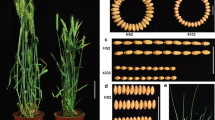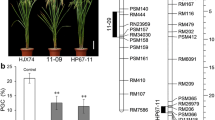Abstract
Key message
A novel QTL cluster for chalkiness on Chr04 was identified using single environment analysis and joint mapping across 9 environments in Asia and South American. QTL NILs showed that each had a significant effect on chalk.
Abstract
Chalk in rice grains leads to a significant loss in the proportion of marketable grains in a harvested crop, leading to a significant financial loss to rice farmers and traders. To identify the genetic basis of chalkiness, two sets of recombinant inbred lines (RILs) derived from reciprocal crosses between Lemont and Teqing were used to find stable QTLs for chalkiness. The RILs were grown in seven locations in Asia and Latin American and in two controlled environments in phytotrons. A total of 32 (21) and 46 (22) QTLs for DEC and PGWC, most of them explaining more than 10 % of phenotypic variation, were detected based on single environment analysis in T/L (L/T) population, respectively. Seven (2) and 7 (3) QTLs for DEC and PGWC were identified in the T/L (L/T) population using joined analysis across all environments, respectively. Six major QTLs clusters were found on five chromosomes: 1, 2, 4, 5 and 11. The biggest cluster at id4007289-RM252 on Chr04 was a novelty, including 16 and 4 QTLs detected by single environment analysis and joint mapping across all environments, respectively. The detected digenic epistatic QTLs explained up to 13 % of phenotypic variation, suggesting that epistasis play an important role in the genetic control of chalkiness in rice. QTL NILs showed that each QTL cluster had a significant effect on chalk. These chromosomal regions could be targets for MAS, fine mapping and map-based cloning for low chalkiness breeding.



Similar content being viewed by others
References
Ashida K, Iida S, Yasui T (2009) Morphological, physical, and chemical properties of grain and flour from chalky rice mutants. Cereal Chem 86:225–231
Chen HM, Z-g Zhao, Jiang L, X-y Wan, Liu L-l Wu, X-j Wan J-m (2011) Molecular genetic analysis on percentage of grains with chalkiness in rice (Oryza sativa L.). Afr J Biotechnol 10:6891–6903
Cheng F, Zhong L, Zhao N, Liu Y, Zhang G (2005) Temperature induced changes in the starch components and biosynthetic enzymes of two rice varieties. Plant Growth Regul 46:87–95
Cooper NTW, Siebenmorgen TJ, Counce PA (2008) Effects of nighttime temperature during kernel development on rice physicochemical properties. Cereal Chem 85:276–282
Counce PA, Bryant RJ, Bergman CJ, Bautista RC, Wang YJ, Siebenmorgen TJ, Moldenhauer KA, Meullenet J-FC (2005) Rice milling quality, grain dimensions, and starch branching as affected by high night temperatures. Cereal Chem 82:645–648
Cuevas RP, Daygon VD, Morell MK, Gilbert RG, Fitzgerald MA (2010) Using chain-length distributions to diagnose genetic diversity in starch biosynthesis. Carbohydr Polym 81:120–127
Ebitani T, Yamamoto Y, Yano M, Funane M (2005) Analysis of quantitative trait loci for grain appearance, Kasalath alleles increase ratio of whole grains against Koshihikari, in rice. Jpn J Crop Sci 74(Suppl 2):290–291
Fitzgerald MA, Resurreccion AP (2009) Maintaining the yield of edible rice in a warming world. Funct Plant Biol 36:1037–1045
Foley JA, DeFries R, Asner GP, Barford C, Bonan G, Carpenter SR, Chapin FS, Coe MT, Daily GC, Gibbs HK, Helkowski JH, Holloway T, Howard EA, Kucharik CJ, Monfreda C, Patz JA, Prentice IC, Ramankutty N, Snyder PK (2005) Global consequences of land use. Science 309:570–574
Guo T, Liu X, Wan X, Weng J, Liu S, Liu X, Chen M, Li J, Su N, Wu F, Cheng Z, Guo X, Lei C, Wang J, Jiang L, Wan J (2011) Identification of a stable quantitative traitl forp grains with white chalkiness in rice (Oryza sativa L.). J Integr Plant Biol 53:598–607
Hallauer AR, Fo JBM (1988) Quantitative genetics in maize breeding, 2nd edn. Iowa Srate University Press, Ames
He P, Li SG, Qian Q, Ma YQ, Li JZ, Wang WM, Chen Y, Zhu LH (1999) Genetic analysis of rice grain quality. Theor Appl Genet 98:502–508
Jiang LR, Fang XJ (2004) Improvement of appearance traits of elite rice Zhenshan 97B by molecular introgression of targeted about 800 kb interval from indica rice Jiafuzhan genome. Mol Plant Breed 2:453–454
Kang HG, Park S, Matsuoka M, An GH (2005) White-core endosperm floury endosperm-4 in rice is generated by knockout mutations in the C-4-type pyruvate orthophosphate dikinase gene (OsPPDKB). Plant J 42:901–911
Kobayashi A, Bao G, Ye S, Tomita K (2007) Detection of quantitative trait loci for white-back and basal-white kernels under high temperature stress in japonica tice varieties. Breed Sci 57:107–116
Li ZK, Pinson SMR, Paterson AH, Park WD, StanSel JW (1997) Epistasis for three grain yield components in rice (Oryza sativa L.). Genetics 145:453–465
Li Y, Fan C, Xing Y, Yun P, Luo L, Yan B, Peng B, Xie W, Wang G, Li X (2014) Chalk5 encodes a vacuolar H+-translocating pyrophosphatase influencing grain chalkiness in rice. Nat Genet 46:398–404
Lisle AJ, Martin M, Fitzgerald MA (2000) Chalky and translucent rice grains differ in starch composition and structure and cooking properties. Cereal Chem 77:627–632
McCouch S, Cho Y, Yano M, Paul E, Blinstrub M, Morishima H, Kinoshita T (1997) Report on QTL nomenclature. Rice Genet Newslett 14:11–12
Mei HW, Xu JL, Li ZK, Yu XQ, Guo LB, Wang YP, Ying CS, Luo LJ (2006) QTLs influencing panicle size detected in two reciprocal introgressive line (IL) populations in rice (Oryza sativa L.). Theor Appl Genet 112:648–656
Mohanty S (2013) Trends in global rice production. Rice Today 13:44–45
Moldenhauer K, Gibbons J (2004) Rice varieties. In: Champagn ET (ed) Rice: chemistry and technology, 3rd edn. The American Association of Cereal Chemists, St Paul, pp 49–75
Murray MG, Thompson WF (1980) Rapid isolation of high molecular weight plant DNA. Nucl Acids Res 8:4321–4326
Patindol J, Wang Y-J (2003) Fine structures and physicochemical properties of starches from chalky and translucent rice kernels. J Agric Food Chem 51:2777–2784
Phan TTT, Ishibashi Y, Miyazaki M, Tran HT, Okamura K, Tanaka S, Nakamura J, Yuasa T, Iwaya-Inoue M (2013) High temperature induced repression of the rice sucrose transporter (OsSUT1) and starch synthesis-related genes in sink and source organs at milky ripening stage causes chalky grains. J Agron Crop Sci 199:178–188
Shirasawa K, Sasaki K, Nagano K, Kishitani S, Nishio T (2006) QTL analysis of high-temperature-stress tolerance in filling period based on rice grain quality. Breed Res 8(Suppl 1):155
Swamy YMI, Bhattacharya KR (1979) Breakage of rice during milling—effect of kernel defects and grain dimension. J Food Proc Eng 3:29–42
Tabata M, Hirabayashi H, Takeuchi Y, Ando I, Iida Y, Ohsawa R (2007) Mapping of quantitative trait loci for the occurrence of white-back kernels associated with high temperatures during the ripening period of rice (Oryza sativa L.). Breed Sci 57:47–52
Tan YF, Xing YZ, Li JX, Yu SB, Xu CG, Zhang Q (2000) Genetic bases of appearance quality of rice grains in Shanyou 63, an elite rice hybrid. Theor Appl Genet 101:823–829
Tashiro T, Ebata M (1975) Studies on white belly rice kernels. 3. Effect of ripening conditions on occurrence of white belly kernel. Proc Crop Sci Soc Jpn 44:86–92
Tashiro T, Wardlaw IF (1991) The effect of high-temperature on kernel dimensions and the type and occurrence of kernel damage in rice. Aust J Agric Res 42:485–496
Terao T, Chiba M, Hirose T, Matsumura O (2004) Quantitative trait loci for the quality of brown rice and their interaction to environmental factors. Jpn J Crop Sci 73(suppl 1):96–97
Thomson MJ, Zhao K, Wright M, McNally KL, Rey J, Tung CW, Reynolds A, Scheffler B, Eizenga G, McClung A, Kim H, Ismail AM, Ocampo Md, Mojica C, Reveche MY, Dilla-Ermita CJ, Mauleon R, Leung H, Bustamante C, McCouch SR (2012) High-throughput single nucleotide polymorphism genotyping for breeding applications in rice using the BeadXpress platform. Mol Breed 29:875–886
van Ruiten HT (1985) Rice milling: an overview. In: Juliano BO (ed) Rice chemistry and technology, 2nd edn. The American Association of Cereal Chemists, St Paul, pp 349–379
Wan XY, Wan JM, Weng JF, Jiang L, Bi JC, Wang CM, Zhai HQ (2005) Stability of QTLs for rice grain dimension and endosperm chalkiness characteristics across eight environments. Theor Appl Genet 110:1334–1346
Wang X, Zhao X, Zhu J, Wu W (2006) Genome-wide investigation of intron length polymorphisms and their potential as molecular markers in rice (Oryza sativa L.). DNA Res 12:417–427
Yamakawa H, Hirose T, Kuroda M, Yamaguchi T (2007) Comprehensive expression profiling of rice grain filling-related genes under high temperature using DNA microarray. Plant Physiol 144:258–277
Yang J, Hu C, Hu H, Yu R, Xia Z, Zhu J (2008) QTLNetwork: mapping and visualizing genetic architecture of complex traits in experimental populations. Bioinformatics 24:721–723
Zhao X, Fitzgerald M (2013) Climate change: implications for the yield of edible rice. PLoS One 8:e66218
Zhou L, Liang S, Ponce K, Marundon S, Ye G, Zhao X (2015) Factors affecting head rice yield and chalkiness in indica rice. Field Crops Res 172:1–10
Zhu DF, Cheng SH, Zhuang YP, Lin XQ, Chen HZ (2010) Analysis of status and constraints of rice production in the world. Sci Agri Sin 43:474–479
Acknowledgments
The authors thank Dr. Zhikang Li for kindly providing the T/L and L/T populations and linkage map. We also thank Ms. Lucena Samadio, Mr. Fernando Salisi and Mr. Teodoro Atienza for field management and quality evaluation. We appreciate Ms. Supanee Jongdee, Ms. Kuri Victoria Eugenia, Dr. Asfaliza Ramli, Dr. Lihong Xie, Dr. Hosien Rahim Souroush, Dr. Huu-Sheng Lur and Dr. Pedro Blanco kindly planted mapping populations. This research was supported by Australian Centre for International Agricultural Research (ACIAR) and the International Rice Research Institute.
Author information
Authors and Affiliations
Corresponding authors
Ethics declarations
Conflict of interest
The authors declare no competing financial interest.
Additional information
Communicated by L. Xiong.
Electronic supplementary material
Below is the link to the electronic supplementary material.
Rights and permissions
About this article
Cite this article
Zhao, X., Daygon, V.D., McNally, K.L. et al. Identification of stable QTLs causing chalk in rice grains in nine environments. Theor Appl Genet 129, 141–153 (2016). https://doi.org/10.1007/s00122-015-2616-8
Received:
Accepted:
Published:
Issue Date:
DOI: https://doi.org/10.1007/s00122-015-2616-8




